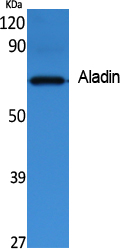Aladin Polyclonal Antibody
- Catalog No.:YT5042
- Applications:WB;ELISA
- Reactivity:Human;Rat
- Target:
- Aladin
- Fields:
- >>Nucleocytoplasmic transport
- Gene Name:
- AAAS
- Protein Name:
- Aladin
- Human Gene Id:
- 8086
- Human Swiss Prot No:
- Q9NRG9
- Mouse Swiss Prot No:
- P58742
- Immunogen:
- Synthesized peptide derived from Aladin . at AA range: 360-440
- Specificity:
- Aladin Polyclonal Antibody detects endogenous levels of Aladin protein.
- Formulation:
- Liquid in PBS containing 50% glycerol, 0.5% BSA and 0.02% sodium azide.
- Source:
- Polyclonal, Rabbit,IgG
- Dilution:
- WB 1:500 - 1:2000. ELISA: 1:40000. Not yet tested in other applications.
- Purification:
- The antibody was affinity-purified from rabbit antiserum by affinity-chromatography using epitope-specific immunogen.
- Concentration:
- 1 mg/ml
- Storage Stability:
- -15°C to -25°C/1 year(Do not lower than -25°C)
- Other Name:
- AAAS;ADRACALA;GL003;Aladin;Adracalin
- Observed Band(KD):
- 59kD
- Background:
- The protein encoded by this gene is a member of the WD-repeat family of regulatory proteins and may be involved in normal development of the peripheral and central nervous system. The encoded protein is part of the nuclear pore complex and is anchored there by NDC1. Defects in this gene are a cause of achalasia-addisonianism-alacrima syndrome (AAAS), also called triple-A syndrome or Allgrove syndrome. Two transcript variants encoding different isoforms have been found for this gene. [provided by RefSeq, Mar 2010],
- Function:
- disease:Defects in AAAS are the cause of achalasia-addisonianism-alacrima syndrome (AAAS) [MIM:231550]; also known as triple-A syndrome or Allgrove syndrome. AAAS is an autosomal recessive disorder characterized by adreno-corticotropic hormone (ACTH)-resistant adrenal failure, achalasia of the esophageal cardia and alacrima. The syndrome is associated with variable and progressive neurological impairment involving the central, peripheral, and autonomic nervous system. Other features such as palmoplantar hyperkeratosis, short stature, facial dysmorphy and osteoporosis may also be present.,function:Plays a role in the normal development of the peripheral and central nervous system.,similarity:Contains 4 WD repeats.,tissue specificity:Widely expressed. Particularly abundant expression is found in cerebellum, corpus callosum, adrenal gland, pituary gland, gatsrointestinal structures and feta
- Subcellular Location:
- Nucleus, nuclear pore complex . Cytoplasm, cytoskeleton, spindle pole . Nucleus envelope . In metaphase cells localizes within the spindle with some accumulation around spindle poles, with the highest concentration between the centrosome and metaphase plate (PubMed:26246606). The localization to the spindle is microtubule-mediated (PubMed:26246606). .
- Expression:
- Widely expressed (PubMed:11159947, PubMed:16022285). Particularly abundant in cerebellum, corpus callosum, adrenal gland, pituitary gland, gastrointestinal structures and fetal lung (PubMed:11159947).
- June 19-2018
- WESTERN IMMUNOBLOTTING PROTOCOL
- June 19-2018
- IMMUNOHISTOCHEMISTRY-PARAFFIN PROTOCOL
- June 19-2018
- IMMUNOFLUORESCENCE PROTOCOL
- September 08-2020
- FLOW-CYTOMEYRT-PROTOCOL
- May 20-2022
- Cell-Based ELISA│解您多样本WB检测之困扰
- July 13-2018
- CELL-BASED-ELISA-PROTOCOL-FOR-ACETYL-PROTEIN
- July 13-2018
- CELL-BASED-ELISA-PROTOCOL-FOR-PHOSPHO-PROTEIN
- July 13-2018
- Antibody-FAQs
- Products Images

- Western Blot analysis of extracts from rat kidney, using Aladin Polyclonal Antibody. Secondary antibody(catalog#:RS0002) was diluted at 1:20000 cells nucleus extracted by Minute TM Cytoplasmic and Nuclear Fractionation kit (SC-003,Inventbiotech,MN,USA).



